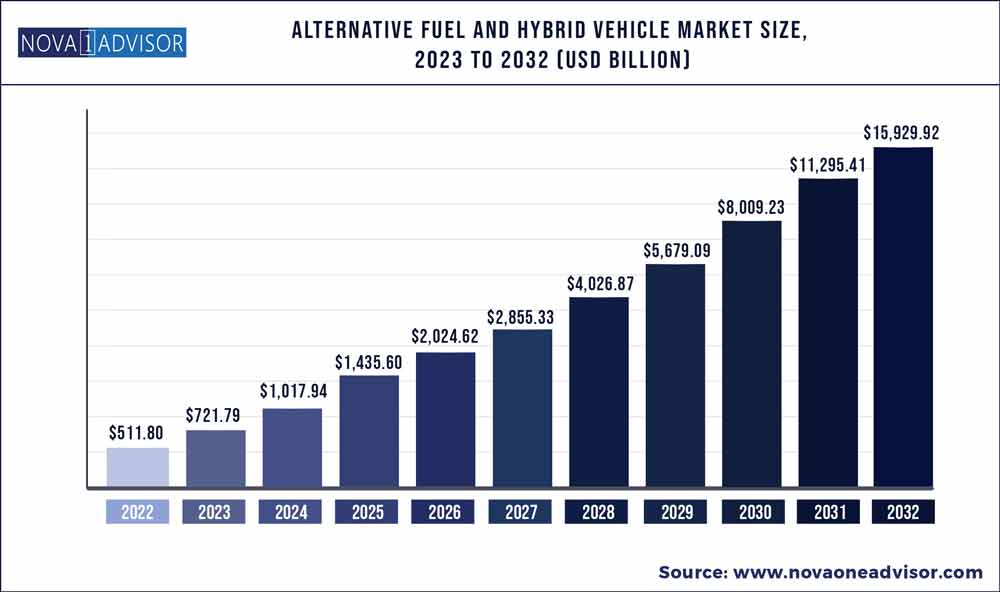The global alternative fuel and hybrid vehicle market size was exhibited at USD 511.8 billion in 2022 and is projected to hit around USD 15,929.92 billion by 2032, growing at a CAGR of 41.03% during the forecast period 2023 to 2032.

Key Pointers:
- By vehicle, the passenger cars segment has accounted 82% market share in 2022.
- By fuel type, the battery-electric vehicles segment contributed 45% market share in 2022.
- Asia Pacific region accounted highest revenue share of around 44% in 2022.
Alternative Fuel and Hybrid Vehicle Market Report Scope
|
Report Coverage
|
Details
|
|
Market Size in 2023
|
USD 721.79 Billion
|
|
Market Size by 2032
|
USD 15,929.92 Billion
|
|
Growth Rate From 2023 to 2032
|
CAGR of 41.03%
|
|
Base Year
|
2022
|
|
Forecast Period
|
2023 to 2032
|
|
Segments Covered
|
Fuel Type, Vehicle Type, Vehicle Class
|
|
Market Analysis (Terms Used)
|
Value (US$ Million/Billion) or (Volume/Units)
|
|
Regional Scope
|
North America; Europe; Asia Pacific; Central and South America; the Middle East and Africa
|
|
Key Companies Profiled
|
Jaguar Land Rover Automotive Plc, Shell International, Mitsubishi Motors Corporation, Ford Motor Company, BYD Company Ltd, Tesla, Daimler AG, Nissan Motor Corporation, Toyota Motor Corporation, Honda Motor Co, Ltd, Mercedes- Benz Group AG, Volkswagen AG
|
Alternative fuel vehicle is a vehicle designed to operate on compressed natural gas, electricity, biofuel, bio-diesel, fuel cell, liquid nitrogen, and dimethyl ether. Different types of natural gas vehicles include, dedicated vehicles, bi-fuel vehicles, and dual fuel vehicles. Plug-in hybrid electric vehicles are considered as alternative fuel vehicle, as the primary input fuel is electricity. Moreover, alternative fuel vehicles create less or no CO2 emissions and also aid in reducing the pollution.
The global decrease in oil reserves, growth in prices of fossil fuels, increase in adoption of clean mobility solutions, stringent government norms for emission control, and growth in supportive government policies to promote adoption of alternative fuel vehicles are factors that drive the growth of the market. However, low fuel economy and performance associated with alternative fuel vehicles and lack of infrastructure to support alternative fuel vehicles are factors expected to hamper the growth of the market. Furthermore, development of charging infrastructure, electrification of public fleet, and technological advancements are expected to offer growth opportunities during the forecasted period.
The alternative fuel and hybrid vehicle market is segmented on the basis of fuel type, vehicle type, vehicle class, and region. By fuel type, the market is fragmented into hybrid vehicles, plugin hybrid vehicles, battery electric vehicles, and others. On the basis of vehicle type, it is fragmented into passenger cars, light commercial vehicles, and heavy commercial vehicles. Based on vehicle class, the market is divided into economical vehicles, mid-priced vehicles, and luxury vehicles. By region, the report is analyzed across North America, Europe, Asia-Pacific, and LAMEA.
Several countries across the globe face rise in the price of fossil fuels. For instance, in 2021, Europe registered increase in gas prices owing to several factors, such as reduced gas supply from Russia, low storage levels, extreme weather conditions, and carbon pricing. This increase in price of fossil fuels results in adoption of vehicles running on alternate fuel as a future mobility solution. Moreover, fossil fuel-based vehicles emit harmful gases and contribute to increased level of pollution. However, vehicles based on alternative fuel do not emit CO2 emissions or harmful gases, which make alternative fuel vehicle an efficient mobility solution with low operating cost. Hence, growth in prices of fossil fuel is expected to contribute in increase in adoption of alternative fuel and hybrid vehicle during the forecast period.
Increase in the adoption of clean mobility solutions is observed globally due to climatic changes. Continuous usage of fossil fuels in automobiles is a major factor resulting in climate change. Vehicles that run on alternative fuels, such as natural gas, electricity, biofuel, bio-diesel, fuel cell, liquid nitrogen, and dimethyl ether result in lesser carbon emissions. Increasing environmental concerns among consumers, introduction of stringent emission regulations, and launch of advanced vehicles supporting alternative fuels are expected to increase the adoption of alternative fuel and hybrid vehicle market during the forecast period.
Some of the prominent players in the Alternative Fuel and Hybrid Vehicle Market include:
- Jaguar Land Rover Automotive Plc
- Shell International
- Mitsubishi Motors Corporation
- Ford Motor Company
- BYD Company Ltd
- Tesla
- Daimler AG
- Nissan Motor Corporation
- Toyota Motor Corporation
- Honda Motor Co, Ltd
- Mercedes- Benz Group AG
- Volkswagen AG
Segments Covered in the Report
This report forecasts revenue growth at global, regional, and country levels and provides an analysis of the latest industry trends in each of the sub-segments from 2018 to 2032. For this study, Nova one advisor, Inc. has segmented the global Alternative Fuel and Hybrid Vehicle market.
By Fuel Type
- Hybrid Vehicles
- Plugin Hybrid Vehicles
- Battery Electric Vehicles
- Heavy Commercial Vehicles
- Others (Fuels, Gaseous, Biofuels)
By Vehicle Type
- Passenger Cars
- Light Commercial Vehicles
- Heavy Commercial Vehicles
By Vehicle Class
- Economical vehicles
- Mid-priced vehicles
- Luxury vehicles
By Region
- North America
- Europe
- Asia-Pacific
- Latin America
- Middle East & Africa (MEA)

